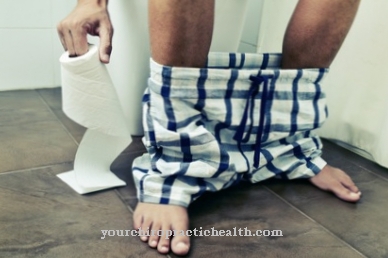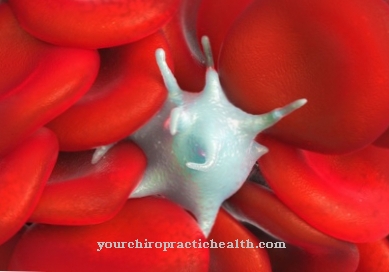The amount of fluids that we drink every day has to be excreted through the urinary tract. The discharge from the body takes place via the emptying of the bladder - the micturition - instead of.
What is micturition?

The term micturition stands in medical jargon for the emptying of the urinary bladder. Controlling the emptying of the bladder is a complex interplay. In the urinary bladder, receptors in the bladder wall react to the degree of filling of the bladder. When the pressure rises, they report the urge to urinate and we get the feeling of having to go to the toilet.
Older children and adults can usually control this process consciously, delaying going to the toilet or giving in to the urge to urinate and emptying the bladder. At a certain point when the bladder is filled, however, urination can no longer be controlled and works reflexively. How intense the bladder pressure is experienced is individual.
Through targeted bladder training, bladder emptying can be trained. This training is used for therapy for incontinence problems, but can also be used when a person has the feeling that they have to go to the toilet very often without having drunk a lot. In most cases, this feeling arises from the habit of going to the toilet very often. Conscious prolonged endurance can now delay the urge to bladder.
Function & task
The fluid that we ingest every day must be appropriately processed by the body and then drained out of the body again. This happens through the urinary tract. The fluid is converted to urine in the kidneys and from there passed through the ureter into the urinary bladder.
The urinary bladder is a hollow organ and serves as a storage organ for urine. Up to a maximum of 800 ml of urine can be collected there. A urge to urinate occurs with a volume of about 200 to 400 ml of urine. From about 800 ml urine in the bladder, however, voluntary control is no longer possible.
From time to time the bladder needs to be emptied and the urine removed from the body. During the phase in which the bladder slowly fills, the bladder muscles remain inactive and expand with the amount of urine so that they can absorb the urine. The bladder remains closed by the sphincter muscle. If it is filled more and more, it creates an urge to urinate. The emptying can be controlled by will. When the bladder is emptied, the bladder muscles contract, the sphincter muscle becomes flaccid and the bladder can be emptied.
When the urge to urinate increases, people seek out the toilet to empty the bladder. How often it has to be emptied varies from person to person. Depending on the amount of fluid we have absorbed, we urinate up to 8 times a day.
Urination takes place in 4 phases. At the beginning, the bladder muscles contract. By contracting, the internal sphincter opens in front of the urethra, followed by the external sphincter. The urine then flows out through the urethra. This process is supported by the abdominal and pelvic floor muscles.
The process of micturition is controlled by the brain. The bladder muscles react to the filling volume in the bladder and report impulses to the brain via the nerve tracts. When there is about 350 ml of urine in the bladder, the cerebrum registers the urge to urinate and controls the emptying reflex via the spinal cord when urinating by sending impulses to contract the bladder muscles and to relax the inner and outer sphincter.
The reflex to emptying the bladder can be suppressed and controlled to a certain extent, while the brain sends inhibitory impulses to the bladder muscles via the spinal cord. In some people, especially the elderly or with incontinence problems, voluntary control can be impaired and must be practiced again through therapeutic measures.
You can find your medication here
➔ Medicines for bladder and urinary tract healthIllnesses & ailments
If the interplay between the emptying of the bladder does not work optimally, it can lead to disruptions and associated complaints. When urinating normally, the bladder is completely emptied several times a day. In the case of difficult emptying of the bladder (dysuria) due to a narrowed or blocked urethra, e.g. If you have an enlarged prostate, bladder stones or tumors, urination can be painful.
Infections, pregnancy, tumors and an indwelling catheter can lead to frequent evacuations of the bladder, but in which only little urine is passed (pollakiuria).
With a polyuria, an excessive amount of urine is excreted each day. The reasons are usually diabetes mellitus or the use of diuretic drugs.
If you have nocturia, people have to empty their bladder at night despite consuming normal amounts of fluid. The cause can be a weak heart or a bladder infection. Sometimes, however, it is simply a psychological assumption that suggests a high urge to urinate.
Urinary retention (anuria) can occur due to mechanical obstacles in the urinary tract such as stones, tumors, foreign bodies or an enlarged prostate, but also due to psychological influences such as a blockage from urinating in the presence of other people (paruresis). With urinary retention there is a risk of residual urine formation, which can lead to a bladder infection, which is usually associated with pain and burning sensation when urinating.
With irritable bladder there is a frequent need to urinate, often combined with a fear of not being able to reach a toilet in time. The irritable bladder is also sensitive to cold. If the bladder is weak (incontinence), urine is accidentally leaked, which is associated with shame for those affected.
There are different forms of incontinence in which the bladder closure mechanism does not work optimally or the physical interaction of micturition is disturbed by various influences. They include stress incontinence, urge incontinence, overflow incontinence, reflex incontinence, and extraurethral urinary incontinence.

























.jpg)

.jpg)
